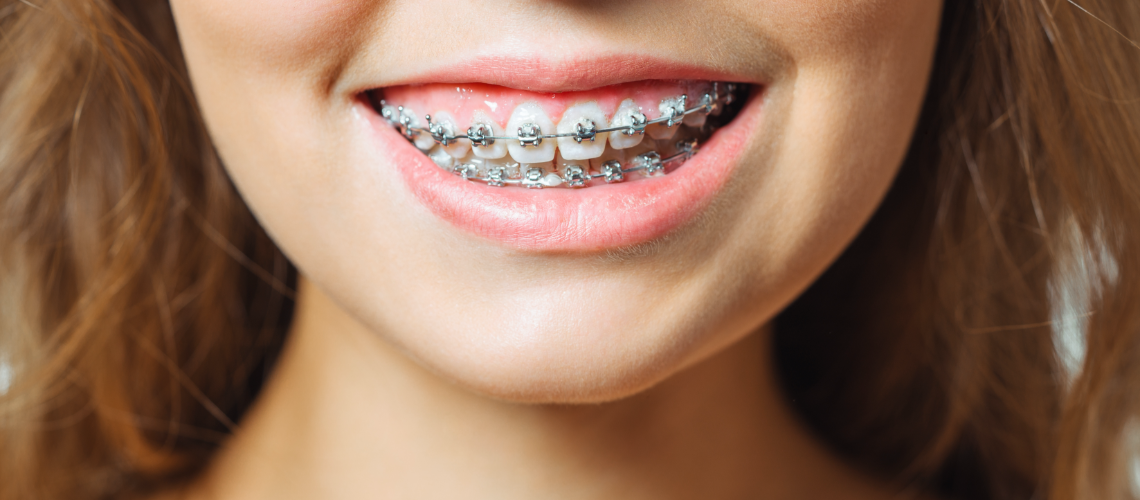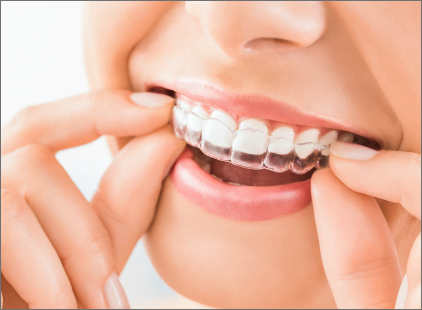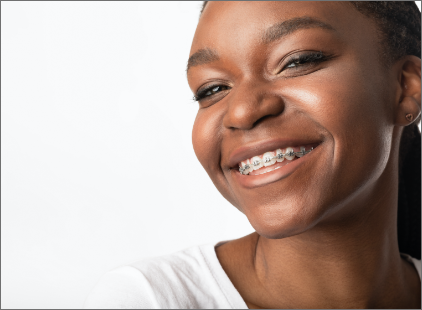
Orthodontics
Orthodontics is a branch of dentistry specializing in the diagnosis, prevention, and treatment of jaw, face and bite irregularities (malocclusions*). Orthodontic treatment is provided by an oral health care provider known as an Orthodontist, who has typically completed two to three years of additional training beyond dental school.
Recent years have brought about many changes within the dental industry, specifically with regards to orthodontic treatment and care. Now more than ever patients are experiencing fewer incidences of cavities and missing teeth due to the heightened awareness of fluoride use and preventative dentistry. This increasing awareness on the health and look of a patient’s smile has fueled the desire for many to seek out orthodontia not only as a medical necessity, but for cosmetic reasons as well.
Whether it’s traditional braces or custom made removable appliances, orthodontics can help you have the healthy, straight, beautiful smile you’ve been waiting for!
Give us a call today and schedule your orthodontic consultation!
*Malocclusion is the technical term for teeth that don’t fit together correctly. Malocclusions not only affect the teeth, but also the appearance of the face. Most malocclusions are inherited; however some are due to acquired habits such as thumb sucking and tongue thrusting. The spacing left from an adult tooth being extracted or an early loss of a baby tooth can also contribute to a malocclusion.


Orthodontics is one of many dental specialties. The word “orthodontics” is derived from the Greek words orthos, meaning proper or straight and odons meaning teeth. Orthodontics is specifically concerned with diagnosing and treating tooth misalignment and irregularity in the jaw area. Initially, orthodontic treatments were geared toward the treatment of teens and pre-teens, but these days around 30 percent of orthodontic patients are adults.
There are many advantages to well-aligned teeth, including easier cleaning, better oral hygiene, clearer speech and a more pleasant smile. Though orthodontic treatment can be effective at any age, the American Dental Association suggests that an orthodontic assessment should be performed around the age of seven. The earlier orthodontic treatment begins, the more quickly the problem can be successfully resolved.
What problems can be treated with orthodontics?
Orthodontics is a versatile branch of dentistry that can be used alone, or in combination with maxillofacial or cosmetic dentistry.
Here are some of the common conditions treated with orthodontics:
- Anteroposterior deviations – The discrepancy between a pair of closed jaws is known as an anteroposterior discrepancy or deviation. An example of such a discrepancy would be an overbite (where the upper teeth are further forward than the lower teeth), or an underbite (where the lower teeth are further forward then the upper teeth).
- Overcrowding – Overcrowding is a common orthodontic problem. It occurs when there is an insufficient space for the normal growth and development of adult teeth.
- Aesthetic problems – A beautiful straight smile may be marred by a single misaligned tooth. This tooth can be realigned with ease and accuracy by the orthodontist. Alternatively, orthodontists can also work to reshape and restructure the lips, jaw or the face.
Orthodontic Solutions
Orthodontics is a technologically advanced field which offers many sophisticated solutions to malocclusions and other cosmetic problems. The orthodontist will generally perform a visual examination, panoramic x-rays and study models (bite impressions) in order to assess the exact nature of the discrepancy.
When a diagnosis has been made, there are a variety of orthodontic treatment options available.
Here is an overview of some of the most common treatments:
- Fixed orthodontic braces – A metal or ceramic dental base is affixed to each tooth, and a dental wire is inserted through each base. The orthodontist is able to gradually train the teeth into proper alignment by regularly adjusting the wire. When the desired results are achieved, the fixed dental braces are completely removed.
- Removable appliances – There are a wide range of removable appliances commonly used in orthodontics, including headgear that correct overbites, Hawley retainers that improve the position of the teeth even as the jawbone reforms, and facemasks which are used to correct an underbite.
- Invisalign® – This is a newer, removable type of dental aligner that is completely transparent. Invisalign® does not interfere with eating because of its removable nature, and mechanically works in the same way as the traditional metal dental braces. Not all patients are candidates for Invisalign®.
If you have any questions or concerns about orthodontics, please contact our office.
A malocclusion is an incorrect relationship between the maxilla (upper arch) and the mandible (lower arch), or a general misalignment of the teeth. Malocclusions are so common that most individuals experience one, to some degree. The poor alignment of the teeth is thought to be a result of genetic factors combined with poor oral habits, or other factors in the early years.
Moderate malocclusion commonly requires treatment by an orthodontist. Orthodontists are dentists who specialize in the treatment of malocclusions and other facial irregularities.
The following are three main classifications of malocclusion:
- Class I – The occlusion is typical, but there are spacing or overcrowding problems with the other teeth.
- Class II – The malocclusion is an overbite (the upper teeth are positioned further forward than the lower teeth). This can be caused by the protrusion of anterior teeth or the overlapping of the central teeth by the lateral teeth.
- Class III – Prognathism (also known as “underbite”) is a malocclusion caused by the lower teeth being positioned further forward than the upper teeth. An underbite usually occurs when the jawbone is large or the maxillary bone is short.
Reasons for treating a malocclusion
A severe malocclusion may lead to skeletal disharmony of the lower face. In a more extreme case, the orthodontist may work in combination with a maxillofacial dentist to reconstruct the jaw. It is never too late to seek treatment for a malocclusion. Children and adults alike have completed orthodontic realignment procedures and have been delighted with the resulting even, straight smile.
Here are some of the main reasons to seek orthodontic treatment for a malocclusion:
- Reduced risk of tooth decay – A malocclusion often causes an uneven wear pattern on the teeth. The constant wearing of the same teeth can lead to tooth erosion and decay.
- Better oral hygiene – A malocclusion can be caused by overcrowding. When too many teeth are competing for too little space, it can be difficult to clean the teeth and gums effectively. It is much easier to clean straight teeth that are properly aligned.
- Reduced risk of TMJ – Temporomandibular jaw syndrome (TMJ) is thought to be caused by a malocclusion. Headaches, facial pains and grinding teeth during sleep all result from the excessive pressure to the temporomandibular joint. Realigning the teeth reduces pressure, and eliminates these symptoms.
How is a malocclusion treated?
A malocclusion is usually treated with dental braces. The orthodontist takes panoramic x-rays, conducts visual examinations and bite impressions of the whole mouth before deciding on the best course of treatment. If a malocclusion is obviously caused by overcrowding, the orthodontist may decide an extraction is the only way to create enough space for the realignment. However, in the case of an underbite, crossbite or overbite, there are several different orthodontic appliances available, such as:
- Fixed multibracket braces – This type of dental braces consists of brackets cemented to each tooth, and an archwire that connects each one. The orthodontist adjusts or changes the wire on a regular basis to train the teeth into proper alignment.
- Removable devices – There are many non-fixed dental braces available to treat a malocclusion. Retainers, headgear and palate expanders are amongst the most common. Retainers are generally used to hold the teeth in the correct position whilst the jawbone grows properly around them.
- Invisalign® – These dental aligners are removable and invisible to the naked eye. Invisalign works in much the same way as fixed dental braces, but do not impact the aesthetics of the smile. Not all patients are candidates for Invisalign®.
If you have any questions about malocclusions, please contact our office.
One of the primary concerns people often have about dental braces is the aesthetic impact of the metalwork on their smile. Especially for adults, the prospect of wearing unattractive metal braces for long periods of time can be very discouraging. Invisalign® offers an almost invisible aligning system that straightens teeth fast and contains no metal.
Invisalign® treatment consists of a series of custom-made aligning trays. The dentist changes the trays every several weeks to fit the new tooth configuration. In addition to the reduced visual impact, Invisalign® aligning trays can be temporarily removed for important occasions – meaning that treatment duration is patient-controlled. A great number of people report complete satisfaction with both the Invisalign® treatment and the stunning results.
What kind of bite problems can Invisalign® correct?
Invisalign® corrects the same dental problems as traditional metal braces; the only difference is that Invisalign® trays are almost invisible to the naked eye, and can be removed at will.
Here are some problems that are commonly corrected with Invisalign®:
- Overcrowding – This occurs when there is too little space for the teeth to align normally in the mouth. Overcrowding can cause tooth decay and increase the likelihood of gum disease.
- Large gaps between teeth – This can sometimes occur because teeth are missing or because the jaw continues to grow abnormally.
- Crossbite – This common dental problem occurs when one or multiple upper teeth bite inside the lower teeth. As a consequence, uneven wear can lead to bone erosion and gum disease.
- Overbite – This problem occurs when the upper teeth project further than, or completely cover, the lower teeth. Eventually, jaw pain and TMJ may occur.
- Underbite – This is the inverse of the overbite; the lower teeth project further than, or completely cover, the upper teeth. Eventually, jaw pain and TMJ can occur.
What advantages does Invisalign® offer over traditional braces and veneers?
Traditional dental braces, Invisalign® aligning trays and dental veneers are three different ways to perfect the alignment of the teeth. There are many different considerations to make when considering which treatment will be best, and each of these options works better in certain situations.
Invisalign® differs from traditional braces in that the aligning trays are fully removable. This means that more discipline and commitment is required from the patient. This is not usually a problem since the trays are comfortable and nearly invisible. Almost identical results can be obtained by using either treatment.
Invisalign® is preferable to veneers in many cases because unlike veneers, Invisalign® actually straightens the teeth. Veneers are thin covers that the dentist permanently affixes to the teeth. Teeth must be etched beforehand, meaning that to remove dental veneers, an alternative covering must be constructed. In addition to being somewhat expensive, veneers can break and often last for less than 20 years.
What does Invisalign® treatment involve?
First, the dentist needs to devise an initial treatment plan before creating the special aligning trays. Three-dimensional digital images are taken of the entire jaw. These images allow the dentist to move specific teeth on the screen, view the jaw from different angles, and also foresee what the face might look like in years to come. In essence, this technology can show how Invisalign® trays will change the facial aesthetics.
Once planning is complete, a unique set of aligners is made. The total amount of aligners required varies with each individual case, but 20-29 sets per arch is typical.
What are some considerations when wearing Invisalign® trays?
Life with Invisalign® aligning trays may take several weeks to get used to. The trays should be worn constantly, except when eating and drinking. It is important to remove the trays when consuming food or drink because food can become trapped between the tray and the teeth, causing tooth decay.
Usually, new trays are necessary every two weeks and progress between appointments can be seen with the naked eye. There is no doubt that Invisalign® aligning trays have revolutionized orthodontics. Invisalign® is renowned for being both comfortable and effective.
If you have questions about Invisalign®, please ask your dentist.
